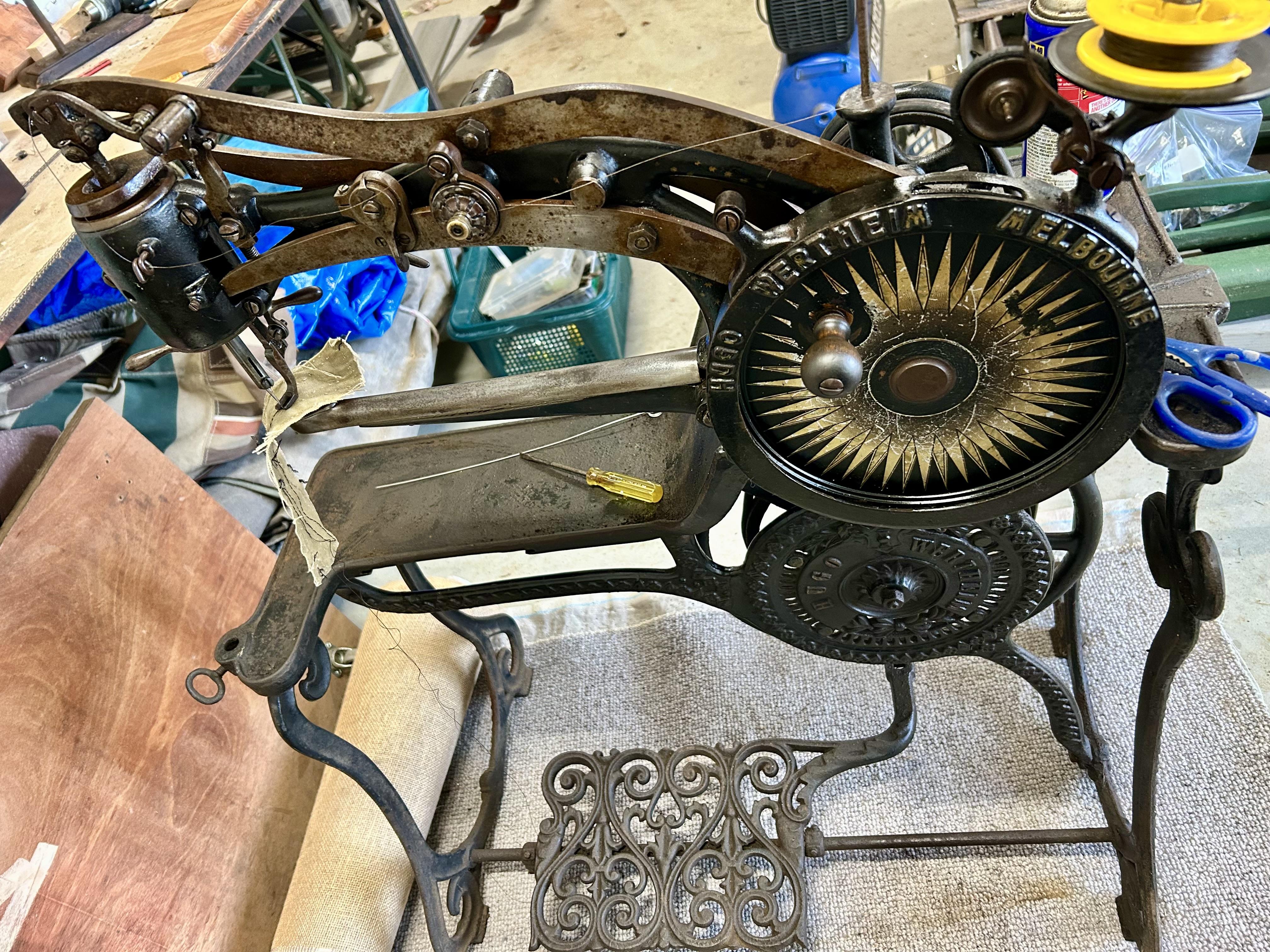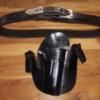All Activity
- Past hour
-
This morning, I brought in a colleague's belt for a repair. It is a Kore "Full Grain" Leather belt with a suede liner and is fitted with some type of a ratchet latch/buckle. It only needed restitched around the last few inches which I did straight away. I noticed that where the belt runs through the buckle, the edge had worn just enough you could see the layer edges so I hit it with dye, let that dry and then followed with Gum T for about three coats burninshing to my limited ability. I noticed the edges (belt is four or five years old) looked perfectly pristine almost like they are formed with epoxy or something yet not cracking or wear seen except where it passed through the buckle. My edging looked ok but would never compare to that factory edge. Is there some process where the maker molds those edges. They've sure held up well but are too difficult for me to duplicate. I'm not so much asking how to duplicated it as I am what in tarnation does the maker do to make that gloss slick (after all these years) edge hold up and look so good? TIA.
- Today
-
Mine was finding out how efficiently a chainsaw can remove teeth. We were cutting firewood all day and I had one last log to finish. Caught the tip on something and it kicked back and got me on the chin and front teeth. I have had saws kick back but never like this one. I had removed the tip guard on the chain thinking it was just in the way. That was a dumb mistake as the saw didn’t have a hand brake as found on all saws today. I soon got me one that did have the hand break. After a couple hundred stitches done by a plastic surgeon and some replacement dental work, I was good to go. I actually was very lucky as it could have a whole lot worse.
-
Thanks a lot everyone. This will help. Dwight, your idea might help he most🤣🤣🤣
-
Hi all, I recently acquired an early Claes bootpatcher, badged “Hugo Wertheim Melbourne”. Its in great condition for such an old machine, filthy but no broken or missing parts, and I have managed to get it stitching with the help of an old manual in German, and the manual for the newer machines, in English. It came with some needles that are too short, I had to slide one needle down in the needle bar till it worked. I am interested if anyone has a manual for these old machines that’s in English. Also and more importantly, I would like to find a source for the proper needles, which I suspect is system 88, or even just the length of this type of needle.. If anyone can help I would be very grateful. Thanks in advance!!
-

Sewing machine for true moccasin footwear
Wizcrafts replied to X24's topic in Leather Sewing Machines
Some Puritan machines have been in service for a century, or longer. Parts wear out over decades of use. Finding replacement parts may be difficult. I believe that Redwing repairs their Puritan machines on-site and probably manufacturers all needed replacement parts, or out-sources them to local machine shops. Here are some references and videos of Puritan Machines in action. https://www.youtube.com/watch?v=RMWAPPEucMI https://www.youtube.com/watch?v=DOVaDCN-BEI Here's one (currently) for sale on eBay, in Pennsylvania. -
They won't. Working them wet . . . you will take them out . . . and when you do they will shrink . . . Nature of the beast. May God bless, Dwight
-
Thanks! I'll keep that in mind. I found one on ebay the other day, but it just ended up being poor timing with the logistics of trying to get it here. They seem like super neat machines.
-
@Dawn Fiorelli You're not going to get any action this way. You should post a proper For Sale ad in The Marketplace. We will require a price, among other things, please review the rules posted at the top of that forum. You could post a question in the Leather Sewing Machine forum with pictures, if you'd like some help establishing a fair asking price.
-
I’m working on a tool roll. The tool handles are .5 inches diag. Obviously I want to size them a little small. If I work them wet, how much can I expect it to stretch? im using 4/5 chrome tan leather
-

Sewing machine for true moccasin footwear
Wizcrafts replied to X24's topic in Leather Sewing Machines
Redwing boots are sewn on Puritan chainstitch machines. Some have 4 or more needles to sew parallel lines at critical seams on the boots. I guess it wouldn't hurt to contact them and ask if they have any Puritans they want to sell off. - Yesterday
-
Agreed. My current thoughts are to motorized the CLSP and get all I can from it. I think I'll keep an eye out for a Puritan chain stitcher, because they clearly work well for this style of construction.
-
Development of best servo motor for leather sewing machine
GerryR replied to CowBoyOUTLAW's topic in Leather Sewing Machines
In the system I have (AC-VFD), the motor is spec'd at 35-459 RPM, 10-90 Hz. That is the output from the 5:1 reducer (gearmotor). I have a 1-1/2" motor pulley going to a 7" drive pulley for another 4.67 reduction giving 7.5 RPM at the machine at 10 Hz (minimun specified operating frequency for the motor), which amounts to 0.125 revs.per second or 1 revolution every 8 seconds. But that is not the point. The point is that when I hit the pedal, and the motor starts to move, I am easily in the safe operating zone of the motor, 10 Hz minimum. It would be absurd to run the machine at 1 stitch every 8 seconds for any length of time. The idea is to keep the motor happy and stll be able to do some controlled slow stitching. Just my $.02 -
Maybe motorizing the patcher will be all you need. If not, buy whichever machine will replace the most work for you. Sewing machines are a deep, expensive rabbit hole.
-
Despite all of the improvements made in electronic motors over the last almost 20 years, I can still feather a clutch motor so it barely turns over the machine, and hold it at a slow and steady speed. Yes, they are noisy and generate a bit of heat. But, they are like the Ever Ready Bunny: they just keep on going! If anybody reads this and is having trouble controlling a clutch motor, try backing off the big screw on the clutch housing. This adds a certain amount of slack movement before the disks engage. You can also tighten the coil spring that holds back the clutch lever. That keeps the lever up and away from engaging accidentally. Finally, you can smear a little grease on the internal cork disk that mashes into the main disks. The final adjustment is to replace a large motor pulley with a 2 inch pulley, or to add a 2:1 speed reducer.
-

Development of best servo motor for leather sewing machine
AlZilla replied to CowBoyOUTLAW's topic in Leather Sewing Machines
Of course, I had to run the numbers. A 30MM motor pulley, (2) 2:6 reducers and a 3.5" hand wheel gives a 1:31.5 reduction. 100 RPM becomes 3.2 at the hand wheel. 20 seconds per stitch! -
I highly suspected that was the case, I was just curious if anyone more experiencd had any other ideas. I will likely just motorize my CLSP for now, as my main complaint is not having two hands to hold the work piece when stitching. Neither a cylinder arm, nor a post bed, can sew everything I'd like on my uppers. But this stupid little manual machine can do most things I want. And it can push thick thread through a good chunk of material. To replace it, I'd basically need to grab a cylinder arm and post bed at the same time.
-

Development of best servo motor for leather sewing machine
dikman replied to CowBoyOUTLAW's topic in Leather Sewing Machines
I did that once - a snail was fast in comparison! An interesting experiment but not very practical. Bottom line here is the Kinedyne (Hightex) motor is doubtless a good motor but if I had one, which isn't likely given the cost, I would still fit a speed reducer. And I don't need all the other gimmicks fitted to it. -

Singer 45k25 - is it worth $1200?
dikman replied to MackProvisions's topic in Leather Sewing Machines
Yep, pass on it. Old machines like that are a) good for restorers, b) good for collectors or c) could be a useful machine for someone who knows what they're doing - IF the price is right. Which it isn't. -
Farming is definitely one of the more hazardous occupations there is. My great-grandfather was killed back in the early 1900's when the horses were frightened by one of those newfangled 'horseless carriages' and ran away. He fell off the seat of the reaper, and his foot got caught in the sheaf carrier strap. He was dragged back to the barn with his head banging on the ground, and suffered a fatal brain injury. My dad's youngest brother was using the hay elevator to load corn cobs into a silo, and the cuff of his overalls got caught on the elevator. The woman helping him didn't know where the shutoff switch was, so had to run a fair distance to unplug the cord from the outlet. By that point, Gord was hanging from the top of the elevator by his ankles, with the elevator belt running over them. He was in a wheelchair for a couple of months. They set up an intercom system from the house to the barn, so he could supervise his sons while they were doing the milking and chores. That did not always go well. One day they got into a fight while Gord and his wife were entertaining company. The language coming over the intercom wasn't exactly 'family friendly'! Another time, his second oldest son was riding on the back of the tractor while his father was moving a disc harrow from one field to another. When he hit the hump from the field to the grass, his son fell off and was run over by the harrow. Broken leg and some internal injuries. Thank God it wasn't the chisel harrow... His friends at school weren't very sympathetic. They'd stick tacks in the rubber ends of his crutches so they'd slip on the floor... When my dad was in his old age, he developed respiratory problems, probably as the result of all the dust he inhaled while working on the farm. His chest x-ray showed a healed fracture of one of his ribs. "When did you break a rib?" I asked. He had to think for quite a few minutes. "I guess it was the time I stepped back so my dad could drive the Model T into the barn loft, and someone had left the trap door open. I fell through it and hit the concrete edge of the pig pen, and was knocked unconscious." He came to a short time later, lying on the daybed in the kitchen. His dad had brought a rare treat back from the store in town: a brick of ice cream. "Come and get your ice cream, Harvey, before it melts," his mom said, when she saw he was awake. A broken rib and a concussion. No doctor's office visit, just "Come and get some ice cream..." Farm kids sure are tough!
-
Repair of Shooting Jacket button holes
Leather Repair Center replied to PAMuzzle's topic in How Do I Do That?
Good point! Otherwise jacket will be back for repair 😁 -
First thing I would do is help him find a diet he could live with. Then I'd follow Leather Repair Center's plan May God bless, Dwight
-
abdolay joined the community
-
New member from San Francisco
Leather Repair Center replied to Leather Repair Center's topic in Member Gallery
I don’t use any sewing machines yet — I’m just getting started in the leather repair business. Right now I focus on fixing existing leather car seats, but I don’t do full upholstery replacements yet. Planning to offer that down the line, since there’s definitely strong demand and good money in this niche. The guy I’m learning from uses the Juke sewing machine, so when the time comes, I’ll probably go with that brand too. -
Singer 45k25 - is it worth $1200?
DocReaper replied to MackProvisions's topic in Leather Sewing Machines
I'd say pass on this purchase. You gotta agree it's antiquated and you have to replace parts they're gonna to be tough to obtain and expensive! -
Repair of Shooting Jacket button holes
Leather Repair Center replied to PAMuzzle's topic in How Do I Do That?
Hey all, I’m in the leather repair niche — mostly work on furniture, auto, and commercial seating — so I don’t typically deal with jackets, but this caught my interest. I showed the photos and details of how I would fix it to my AI assistant and asked how we might repair this jacket, and it gave some solid advice that lines up exactly with how I’d approach it. Here’s what it suggested: AI’s Recommendation: 1. Remove the Damaged Panel: Carefully unstitch the torn synthetic leather piece, using it as a template. 2. Replace with Genuine Leather: Cut a replacement patch from 2–3 oz genuine leather (not too thick, but durable). This will hold up better than the original material which looks like thin vinyl or bonded leather. 3. Reinforce from the Back: Use a strong woven backing or thin nylon webbing glued behind the leather to add strength and prevent future tearing. 4. Recut and Reinforce Buttonholes: Recreate the slits and stitch around them tightly, or even use grommets if appropriate. If possible, roll the leather edges or saddle stitch for extra strength. 5. Stitch Panel Back in Place: Sew the new piece back over the original location, making sure it’s clean and matches the rest of the jacket. Optional: carry the leather around to the front as a decorative piece, which would both look good and reinforce the structure. I’m honestly impressed with the advice the AI gave — this is exactly how I would fix it myself. Hope it’s helpful





